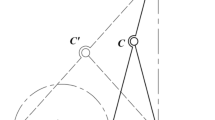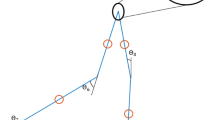Abstract
From a global perspective, Korea is a leader in the field of indoor screen golf technologies. However, some products and technologies that are being used in current indoor screen golf systems have shortcomings with regard to technical stability. Nowadays, hydraulic actuators are widely used in golf swing plate systems to adjust the plate and recreate for the player the slope of the terrain shown on the screen. However, the hydraulic actuators used in screen golf systems have disadvantages associated with them, such as oil leakage, bad control, and high price. To address what we perceive to be a shortage of existing alternatives, we developed a golf swing plate that uses screw actuators to drive the swing plate up and down. We take the opportunity in this study to perform an analysis of the kinematic behavior of our design employing three active PRS (Prismatic joint–revolute joint–spherical joint) legs that provide the golf swing plate with three degrees of freedom. In this paper, we focus on the derivation of kinematic equations and constraints related to kinematic variables. Furthermore, we derive the amount of translation necessary for each prismatic joint to achieve the motions required of the golf swing plate. We go on to verify the complex movement of the swing plate using the NX motion simulation program. Finally, we construct a prototype and test the functions of the golf swing plate.
Similar content being viewed by others
References
B. H. Seo, Impact on the similarity and effect with field of screen golf simulation, Journal of Tourism & Leisure Research, 26 (2) (2014) 337–351.
K.-S. Lee, Study on the kinematic design of a golf swing plate, Program of the 1 st Vietnam–Korea International Conference (2016) 1.
F. Zhang and K.-S. Lee, Development of a golf swing plate, Proc. of the 2016 Spring Conference of KSME Manufacturing and Design Division (2016) 46.
F. Zhang, Development of a golf swing plate through the study of kinematic and control design, Master Thesis, Hanbat National Univ., Korea (2016).
F. Zhang, K.-S. Lee, S. Lang, J. Yuk and S. Kim, Development of golf swing plate using motion simulation method, Proc. of the Society of CAD/CAM Conference (2016) 869–870.
D. Stewart, A platform with six degrees of freedom, Proc. of Institution of Mechanical Engineers, 180 (1) (1965) 371–386.
Wikipedia, Stewart platform, available at https://en.wikipedia.org/wiki/Stewart_platform (2007).
W. Zhou, W. Chen, H. Liu and X. Li, A new forward kinematic algorithm for a general Stewart platform, Mechanism and Machine Theory, 87 (2015) 177–190.
P. Nanua, K. J. Waldron and V. Murthy, Direct kinematic solution of a stewart platform, IEEE Trans. on Robotics and Automation, 6 (4) (1990) 438–444.
J.-H. Park, K.-S Lee, S. U. Lee and H.-S. Park, A passive shoulder joint tracking device for effective upper limb rehabilitation, International Journal of Precision Engineering and Manufacturing, 17 (11) (2016) 1533–1540.
C.-Y. Ko, J. K, H. J. Kim and D Lim, New wearable exoskeleton for gait rehabilitation assistance integrated with mobility system, International Journal of Precision Engineering and Manufacturing, 17 (7) (2016) 957–964.
D. J. Hyun, H. Lim, S. Park and K. Jung, Development of ankle-less active lower-limb exoskeleton controlled using finite leg function state machine, International Journal of Precision Engineering and Manufacturing, 18 (6) (2017) 803–811.
K. Wang, C. Gosselin, X. Wu, Q. Zhang and K. Li, Collision-avoidance trajectory planning for a virtual kinesthetic feedback system, Journal of Mechanical Science and Technology, 30 (7) (2016) 3321–3330.
C. M. Gosselin, The direct kinematics of planar parallel manipulators: Special architectures and number of solutions, Mech Mach Theory, 29 (8) (1994) 1083–1097.
J.-P. Merlet, Direct kinematics of planar parallel manipulators, Proc. of the 1996 IEEE International Conference on Robotics and Automation (1996) 3744–3749.
M. Zein, P. Wenger and D. Chablat, Non-singular assembly-mode changing motions for 3-RPR parallel manipulators, Mech Mach Theory, 43 (2008) 480–490.
Q. Zhang and M.-Y Zhao, Minimum time path planning of robotic manipulator in drilling/spot welding tasks, Journal of Computational Design and Engineering, 3 (2016) 132–139.
K. Sawai, Y. Nomaguchi and K. Fujita, Fundamental framework toward optimal design of product platform for industrial three-axis linear-type robots, Journal of Computational Design and Engineering, 2 (2015) 157–164.
C. Mineo, S. G. Pierce, P. I. Nocholson and I. Cooper, Introducing a novel mesh following technique for approximation-free robotic tool path trajectories, Journal of Computational Design and Engineering, 4 (2017) 192–202.
N. M. Rao and K. M. Rao, Dimensional synthesis of a spatial 3-RPS parallel manipulator for a prescribed range of motion of spherical joints, Mech. Mach Theory, 44 (2009) 477–486.
K. Lee and D. K. Shah, Kinematic analysis of a three degrees of freedom in-parallel actuated manipulator, Proceedings of the IEEE International Conference on Robotics and Automation, 1 (1987) 345–350.
Author information
Authors and Affiliations
Corresponding author
Additional information
Fenglong Zhang received his B.S. (2014) and M.S. (2016) from Hanbat National University. His major research area is mechanical design and CAD.
Kang-Soo Lee received his B.S. (1987), M.S. (1989) and Ph.D. (1999) from Seoul National University. He is currently a Professor at the Department of Mechanical Engineering at Hanbat National University. His major research area is mechanical design and CAD.
Rights and permissions
About this article
Cite this article
Zhang, F., Lee, KS. Research on the kinematic behavior of a golf swing plate. J Mech Sci Technol 31, 5617–5625 (2017). https://doi.org/10.1007/s12206-017-1102-4
Received:
Revised:
Accepted:
Published:
Issue Date:
DOI: https://doi.org/10.1007/s12206-017-1102-4




